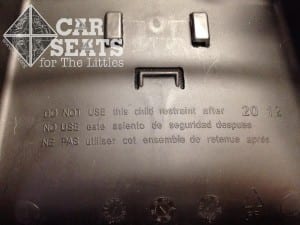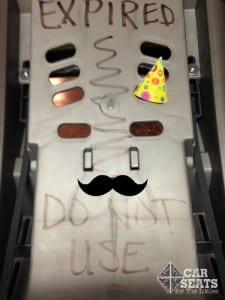
This expired seat will not keep this adorable baby safe. There are several issues which must be addressed.
We’ve all been there. You’ve just poured a bowl of your favorite cereal, and you just can’t wait to get all of that deliciousness in your belly. You open up your jug of milk, and it hits you. That smell. You look at the label and your milk has expired.
Every car seat and booster seat has a life span and an expiration date, just like the bad milk. Except for the smell part. What? You’re thinking, how is this possible? I’ve been saving this seat for the next kiddo since my teenager was little. It’s been sitting in my garage for years, how is it expired??
Well, there are several reasons that car seats and booster seats expire.
Materials break down over time. Most car seats have a plastic shell. Plastic breaks down and degrades over time, becoming brittle. This could be very dangerous if an expired seat is being used in the event of an accident. Remember that time you sat down in a plastic lawn chair that had been sitting outside for several summers, and crashed right through to the ground? The plastic just couldn’t stand up to the combination of age, heat, and sun. The same is possible for a car seat that has extended past its expiration: the plastic could break apart and fail to serve its purpose of keeping a child safe and uninjured in a crash. Most car seats also have metal parts that wear over time. Metal can develop rust in even unseen areas of the car seat and once again, not function properly in an accident.
Technology advances. Child passenger safety is an ever evolving and advancing field. Car seat manufacturers work very hard to manufacture seats that keep up with current best practice recommendations. Many also do their own independent crash testing for things like side impact protection — which there is no current standard for, but the technology is still advancing as more is learned about the best ways to protect children in a crash.

This Overhead Shield seat has not been manufactured for many years due to safety advances for car seats
Replacement parts are no longer available. Once a car seat is out of production, finding replacement parts becomes challenging, then impossible. I recently ran into this situation at a safety event: a parent came in with a seat missing a very important part and the seat was only three months shy of its expiration date. The company could not replace the crucial part because it was no longer being made and the seat had to be destroyed.
How do you know when your car seat or booster seat expires? All car seats and boosters have different lifespans. There is no one rule; seats can expire anywhere from 4-12 years from when they were made. To find out when your seat expires, take a look at the seat itself.
Each seat or booster will have a date of manufacture printed on a sticker that’s somewhere on the seat or stamped into the seat itself; as well as on the registration card that came with the seat. The car seat’s usable lifespan is often listed in the manual as well. Some seats have the expiration stamped into the plastic of the shell saying, “DO NOT USE AFTER” and then a date. Some seats require you to calculate the expiration date by counting forward from the manufacture date. If the seat is missing the stamp, it’s unreadable, or the sticker/manual is missing, consider the seat to be a seat with an unknown history, and therefore unsafe to use.
What should you do with an expired seat or booster? Discontinue using the seat immediately! After that, you could find a way to reuse it around the house, donate it to a local CPST to use for training and demonstration, or simply dispose of it. If you choose to use the seat around the house, don’t use an infant seat as a spot to nap, and make sure that the harness is removed to avoid a strangulation hazard. An expired seat should be disposed of in a way that it won’t be re-used by anyone. The easiest way to go about this is to remove the cover, harness straps, write on it with a sharpie, and place it into a black garbage bag before taking it to be recycled.
This is what a CPST party looks like – a huge pile of expired seats, both harnessed seats and booster seats, waiting for their next stop in the great carousel of life. These seats will no longer be transporting children, so it’s a good day for us when their former occupants are riding in newer seats that are all within their approved lifespans.
While it’s on your mind, go check your children’s seats. Make sure none are nearing expiration, and if you have some that expire in the next year or so – put a reminder in your phone or calendar so you don’t forget to dispose of it on time.
Don’t be surprised if you shed a bit of a tear when that first seat you purchased reaches expiration: it’s a little sad to see them go! I’ve said goodbye to a couple of favorites over the years, it’s always fun remembering how small your Little was when they took their first ride in that old favorite.





